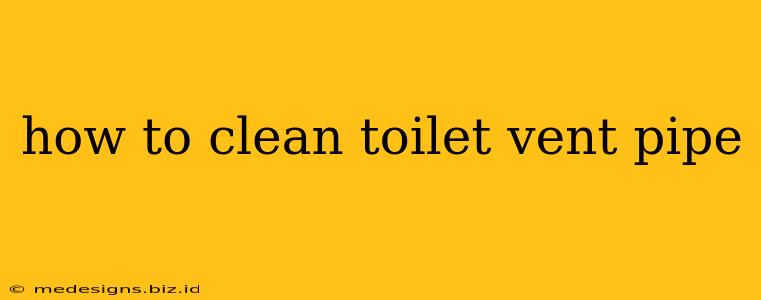A clogged toilet vent pipe can lead to a variety of unpleasant problems, from slow-draining toilets to sewer gasses entering your bathroom. Knowing how to clean your toilet vent pipe is crucial for maintaining a clean and functional plumbing system. This guide provides a step-by-step approach to tackling this often-overlooked plumbing chore.
Understanding Your Toilet Vent Pipe
Before diving into the cleaning process, it's important to understand what a toilet vent pipe is and its function. The vent pipe, also known as a stack vent or vent stack, is a crucial part of your plumbing system. It extends from your toilet drainpipe to the roof of your house. Its primary function is to allow air to enter the drainage system, equalizing pressure and preventing sewer gases from backing up into your home. A blockage in this pipe disrupts this vital air flow, causing various plumbing issues.
Signs of a Clogged Toilet Vent Pipe
Several symptoms indicate a potential clog in your toilet vent pipe. These include:
- Slow-draining toilets: This is a common and often the first sign of a problem.
- Gurgling sounds from drains: Air struggling to pass through the blockage creates these noises.
- Sewer gas odors: This is a serious indicator of a blockage and potential health hazard.
- Toilet water rising slightly during flushing: A lack of air pressure prevents proper drainage.
Cleaning Your Toilet Vent Pipe: A Practical Approach
Cleaning a toilet vent pipe isn't a DIY project for the faint of heart. It often requires specialized equipment and some knowledge of plumbing. While attempting some minor clearing might be possible, significant blockages usually require professional intervention.
1. Assessing the Situation
Begin by carefully inspecting your toilet and other drains. Are there other plumbing issues that might contribute to the problem? Listen for gurgling sounds during flushing. The severity of the problem will guide your next steps.
2. Trying a Minor Clearing (Proceed with Caution!)
For minor blockages, you might attempt to use a plumbing snake or auger. However, use extreme caution! Vent pipes often run through walls and ceilings, and improper use could cause significant damage. If you are unsure about this step, call a professional.
- Access: Locate the vent pipe access point. This is usually on the roof but could be in your attic.
- Caution: Work carefully to avoid damaging the pipe or causing further blockage.
- Limited Scope: A plumbing snake is only suitable for minor debris.
3. When to Call a Plumber
If the problem persists or you are uncomfortable attempting any cleaning yourself, it's best to call a qualified plumber. They have the necessary tools and expertise to effectively and safely clear your vent pipe. A professional plumber can identify the cause of the blockage, and utilize tools like high-pressure water jets to remove stubborn obstructions.
They will also be able to address any underlying plumbing issues that may be contributing to the blockage.
Preventative Measures for a Healthy Vent Pipe
Preventing clogs in your toilet vent pipe is much easier than cleaning one. Here are some preventative measures:
- Regular Maintenance: Schedule an annual inspection of your plumbing system by a professional.
- Careful Disposal: Avoid flushing anything other than toilet paper and human waste. This prevents build-up in the vent pipe.
- Tree Root Prevention: If trees are near your plumbing, their roots can infiltrate the pipes. Consult a plumber to discuss solutions to prevent root intrusion.
Cleaning a toilet vent pipe is often a job best left to the professionals. While attempting minor clearing yourself might seem possible, the potential for damage and health risks outweigh the benefits. Prioritize safety and call a plumber if you experience any persistent problems. A clean vent pipe ensures proper drainage, preventing unpleasant and potentially costly issues in the future.
